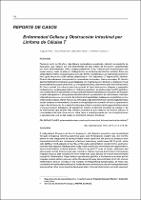| dc.contributor.author | Vera Calderón, Augusto | |
| dc.contributor.author | Frisancho, Oscar | |
| dc.contributor.author | Yábar, Alejandro | |
| dc.contributor.author | Carrasco, Wilmer | |
| dc.date.accessioned | 2019-04-24T17:17:17Z | |
| dc.date.available | 2019-04-24T17:17:17Z | |
| dc.date.issued | 2011 | |
| dc.identifier.citation | Revista de Gastroenterología del Perú. 2011;31(3). | es_PE |
| dc.identifier.issn | 1022-5129 | |
| dc.identifier.uri | https://hdl.handle.net/20.500.12959/433 | |
| dc.description.abstract | Paciente varón de 55 años, raza blanca (ascendencia española), natural y procedente de Ayacucho, que ingresó por una enfermedad de seis meses de evolución, caracterizada por dolor abdominal tipo cólico y baja ponderal de 10 Kg. Había estado hospitalizado seis meses antes y dado de alta con el diagnóstico de síndrome de intestino irritable. Entre sus antecedentes refería intolerancia a la lactosa y artritis reumatoidea. El tránsito gastrointestinal mostró las asas delgadas con fragmentación del bario y dilatación focal moderada de un asa yeyunal distal. La colonoscopia fue normal; el íleon tenía pocos pliegues y pequeñas nodulaciones, las biopsias indicaron “ileitis inespecífica”. La endoscopía mostró gastritis y una cicatriz de úlcera duodenal; la mucosa duodenal mostraba áreas con aspecto de mosaico rosado-blanquecino. La biopsia duodenal evidenció acortamiento de vellosidades, infiltrado inflamatorio crónico e incremento de linfocitos intraepiteliales, hallazgos compatibles con los criterios de celiaquía Marsh-tipo 3. Los anticuerpos IgA antiendomisio y antitransglutaminasa tisular estaban incrementados. Durante su hospitalización aumentó el dolor y aparecieron signos de obstrucción. En la laparotomía se encontraron una tumoración yeyunal estenosante y una perforación adyacente. El espécimen mostró un linfoma intestinal de células T. Se ha demostrado que existen más celiacos subclínicos que celiacos con esprue clásico; el conocimiento de esta situación nos debe llevar a tenerla presente por sus complicaciones o asociaciones, una de las cuales es el linfoma primario intestinal. | es_PE |
| dc.description.abstract | A male patient, 55 years old, born in Ayacucho, with Spanish ancestors, was hospitalized through emergency referring abdominal pain, and 10 kilograms weight loss. Six months before he was diagnosed as having irritable bowel syndrome. His previous diseases were rheumatoid arthritis and intolerance to lactose. Laboratory results were: Hb 12 gr./dL, white cells 5200 per mm3, albumin 2.7 gr./dL, erythrocyte sedimentation rate 32 mm/hr., and tumor markers were negative. Radiographic study of the small bowel showed barium fragmentation, and a focal dilation in distal jejunum. Chest X-ray and CT scan of thorax, abdomen and pelvis were normal. Colonoscopy was normal for colonic mucosa, but in ileum it showed an irregular mucosa, little nodules and fewer folds than usual. Biopsy from ileum demonstrated unspecific inflammation. Upper endoscopy showed gastritis, a duodenum scar ulcer and an irregular mosaic pattern pink and white. Duodenum biopsy demonstrated short villi, chronic inflammation and an increase in the number of intraepithelial lymphocytes, all these was consistent with celiac disease Marsh 3. Antibodies anti-endomisium and anti-transglutaminase were positive. After some days he developed signs of bowel obstruction and was operated.
A tumor was found in jejunum with a bowel perforation. Pathological study showed a small bowel T-cell lymphoma. Fortunately this patient did well, and was sent home to continue treatment on ambulatory basis. Celiac disease is more common than what is thought, and it has been demonstrated that there are more persons with subclinical celiac disease, than those with the typical clinical pattern. It is necessary to be aware of this disease to improve diagnosis in order to avoid late complications as small bowel lymphoma. | |
| dc.format | application/pdf | es_PE |
| dc.language.iso | spa | es_PE |
| dc.publisher | Sociedad de Gastroenterología del Perú | es_PE |
| dc.relation.uri | http://www.scielo.org.pe/scielo.php?pid=S1022-51292011000300010&script=sci_arttext&tlng=en | |
| dc.rights | info:eu-repo/semantics/openAccess | es_PE |
| dc.rights.uri | https://creativecommons.org/licenses/by-nc-nd/4.0/ | es_PE |
| dc.source | Seguro Social de Salud (EsSalud) | es_PE |
| dc.source | Repositorio Institucional EsSalud | es_PE |
| dc.subject | Gastroenterología y Hepatología | es_PE |
| dc.subject | Linfoma de Células T | es_PE |
| dc.subject | Obstrucción Intestinal | es_PE |
| dc.subject | Enfermedad Celíaca | es_PE |
| dc.subject | Celiac disease | |
| dc.subject | Bowel obstruction | |
| dc.subject | Enteropathy-associated T-cell lymphoma | |
| dc.title | Enfermedad celiaca y obstrucción intestinal por Linfoma de Células T | es_PE |
| dc.title.alternative | Celiac disease and intestinal obstruction by T cell lymphoma | |
| dc.type | info:eu-repo/semantics/article | es_PE |
| dc.subject.ocde | https://purl.org/pe-repo/ocde/ford#3.02.19 | es_PE |
| dc.publisher.country | PE | es_PE |






